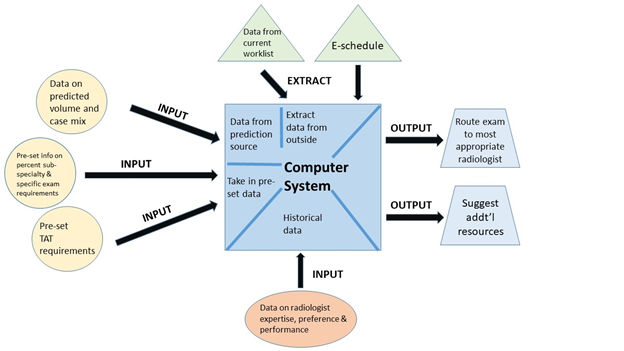|
Purpose |
Increase the number of sub-specialized interpretations,reduce turnaround time, and improve the work balance of radiologists by intelligently routing studies based on optimized staffing levels as well as radiologist training and expertise. The algorithm may also suggest when to request back-up assistance based on predicted workload and staffing. |
|
Tag(s) |
Non-Interpretive |
|
Panel |
Business-Facing |
|
Define-AI ID |
19100006 |
|
Originators |
Rich Heller, Woojin Kim, Worth Saunders |
|
Panel Chair |
Rich Heller |
|
Non-Interpretative Chairs |
Alexander J. Towbin, Adam Prater |
|
Panel Reviewers |
Business Facing Panel |
|
License |
|
|
Status |
Clinical Implementation
Value Proposition
In many places, there is an emphasis on sub-specialized interpretations and optimizing service levels for professional radiology services. Even in radiology practices that do not have the required metrics around sub-specialty interpretations, there is often a desire to have certain types of exams interpreted by radiologists with specific expertise. A system that can intelligently route exams to the most appropriate radiologist could reduce the turnaround time, meet specified requirements, and potentially improve interpretive quality and satisfaction of radiologists.
Narrative(s)
A 17 radiologist practice provides around-the-clock services to a large community hospital and its off-campus outpatient imaging center. The new head of neurosurgery has stated that at least 80% of all advanced neuroimaging (CT and MRI) should be interpreted by a neuroradiologist. The hospital has also begun offering transcatheter aortic valve replacement (TAVR) and the CT interpretations of these patients are done by select radiologists who work with the cardiovascular surgeons. There are also strict turnaround time requirements. The practice would like a system that can automatically route studies to the most appropriate radiologist, balancing the need for sub-specialty interpretations with turnaround times. The ideal system also improves quality by better balancing workload and increasing subspecialty reads, which ideally lowers the number of cases referred to the department for review due to an interpretive quality issue. In addition, since many radiologists prefer to read within their sub-specialty, the system may improve radiologist job satisfaction.
Workflow Description
There are several groups of incoming data. Information on the available radiologists comes from the e-schedule. This can include information on who is scheduled to be working currently, who is logged on and actively working now, and who is supposed to be coming online later. The worklist data, containing information on the specific exams to be read, is also inputted and constantly updated. A separate prediction tool inputs data on expected incoming volume and case mix. Pre-set information on required turnaround times, percent sub-specialty interpretation, and specific exam requirements (i.e., TAVR only by Drs. X, Y, or Z) are also inputted. Additionally, historical data on radiologists is inputted. This can include information on radiologist expertise, including data on sub-specialty training and preference (i.e., they may not be fellowship trained, but they read mostly within a certain sub-specialty and are considered experts in that area) and productivity.
Technical Specifications
Inputs
E-Schedule
|
Definition |
The list of radiologists scheduled to be working, actually online and expected to be online at a certain time. |
|
Potential Feature |
Names of specific radiologists |
Data from current worklist
|
Definition |
Features of an exam such as modality, location of the exam, body part, wRVU, patient demographics, referring provider, and indication, as well as related exams obtained at the same time, all of which could be extracted from the RIS and PACS worklist manager. |
|
Potential Feature(s) |
Modality, Body part, patient demographics (age&sex), indication, referring provider, similar exams ordered at same time, wRVU (per CMS), location of the exam (point of service and location in hospital) |
Data on predicted volume and case-mix
|
Definition |
From a separate prediction tool, input the expected volume of exams as well as the predicted case-mix (ie types of exams) |
|
Potential Feature(s) |
Volume of exams, modality of exams, body part, indication, referring provider, exam location |
Pre-set Information on required sub-speciality interpretations and certain exam types
|
Definition |
The specific requirements to interpret a certain sub-category of the exam (like advanced neuroimaging) from a certain cohort of radiologists (i.e. neuroradiologists). For example, 80% of advanced neuroimaging to be read by neuroradiology. Another example, all TAVR exams to be ready by Rs. X, Y, or Z only. |
|
Potential Feature(s) |
Specific requirement for exam types |
Radiologist Turnaround Times
|
Definition |
Delivery of timely information to the healthcare team as needed; can be defined as the time from report available on the worklist for interpretation to the final report signed |
|
Potential Feature(s) |
Turnaround time |
Data on radiologist expertise, preference & performance
|
Definition |
Information on each radiologist in the practice based on the selection criteria of the facility. This may include radiologist’s preference, the rate of dictation, and subspecialty expertise, as inputted by training or imputed by reading preferences. |
|
Potential Feature(s) |
Radiologist productivity (i.e. exam types read per unit time), radiologist expertise |
Primary Outputs
Route to appropriate radiologist
|
Definition |
Direct exams to the radiologist that will satisfy the preset goals |
Study-Radiologist Pairing
|
Definition |
Suggest when and what type of additional resources would be useful to satisfy preset goals |
Figures
